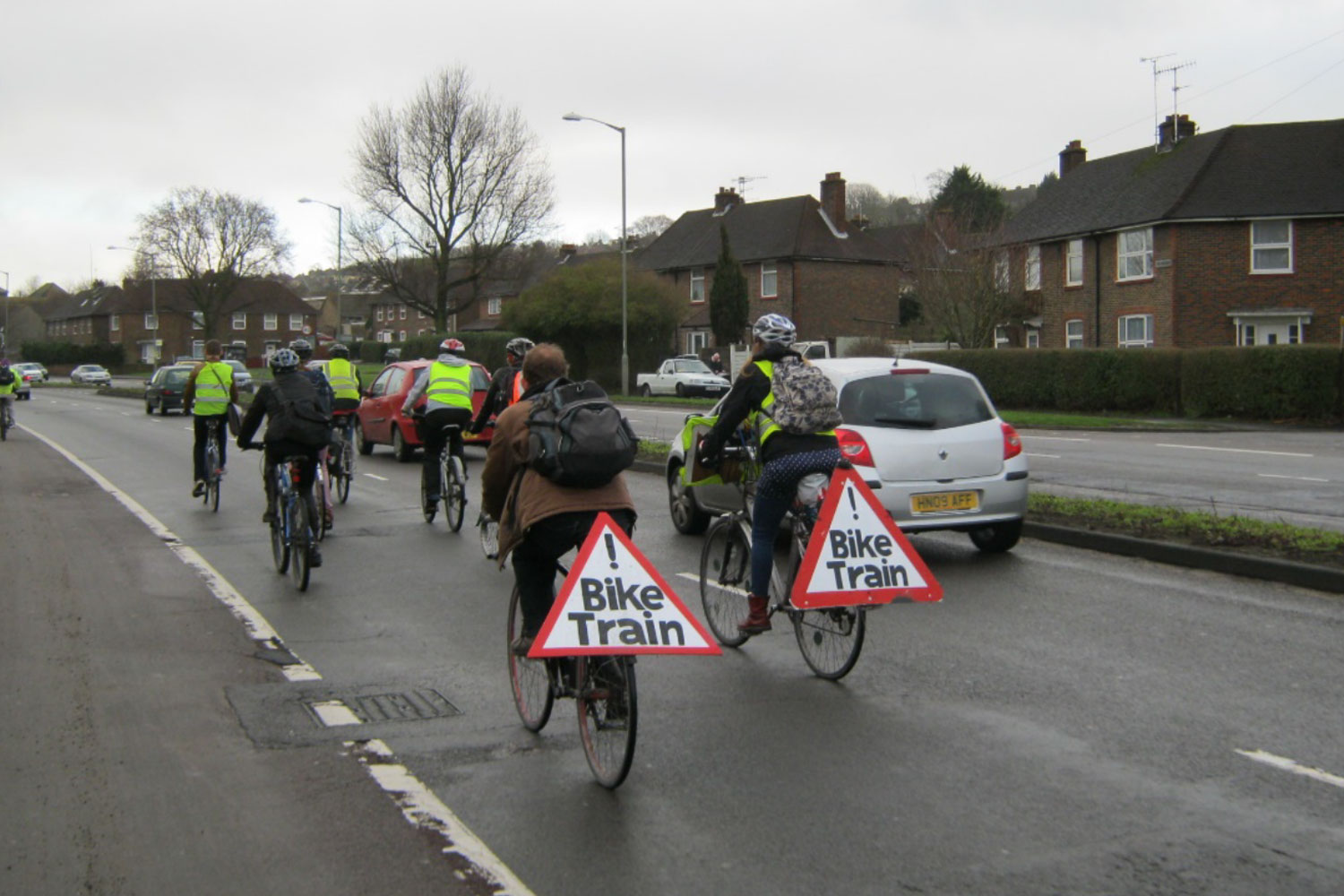A bicycle train is a group of people bicycling together along a structured route with a set schedule and meeting places. Bicycle trains are most commonly seen in the form of parents leading a group of children to school. There are also a number of bicycle trains that have been established across the U.S. for adults commuting to work. This alternative form of transportation is popular because it improves bicyclist safety and can help new cyclists acclimate to commuting via bicycle. There are similar projects for walkers known as the walking school bus, and both types of programs are often funded through the National Safe Routes to School Program.
BENEFITS
ECONOMIC
- Getting cars off of the road reduces overall commute times for both drivers and bicyclists. School districts that encourage bicycle and walking trains may spend less money on school buses.
SOCIAL
- Bicycle and walking trains provide an additional opportunity for physical activity.
- Participating in a train may helps build a sense of community by connecting parents and children and adult participants in a neighborhood or district.
- Teachers have reported that children that bike or walk to school are more prepared to learn in the classroom when the school day begins.
ENVIRONMENTAL
- Bicycle and walk trains reduce the number of trips taken by car, VMT and greenhouse gas emissions.
- Traffic calming devices, which are usually implemented to help promote cycling, often integrate stormwater management into their design.
BARRIERS TO IMPLEMENTATION
INSTITUTIONAL
Schools and organization may not have the infrastructure in place to store an influx of additional bikes. Bicycle trains also require a substantial amount of volunteers (for school bike trains, an average of 1 adult per 4 children). Without supervision, safety issues can arise. There is also a mindset barrier that needs to be broken down; many people may think of cycling as a recreational activity and not as a means of transportation.
FINANCIAL
Bicycle trains require both adults and children to invest in bicycles, helmets and other cycling gear, which can be cost prohibitive to low income populations.
POLITICAL
Routes necessary to take to school or work may be genuinely unsafe. City leaders and community members may not agree with the benefits of bicycle routes, thus creating tension and lack of funding for infrastructure improvements.
CASE STUDY: BICYCLE TRAIN — PORTLAND, OR
IMPLEMENTATION
The Portland Bicycle Train was started in 2010 by 22-year-old college graduate, Kiel Johnson, after a local elementary school banned bicycling to school due to safety concerns. Johnson felt that there had to be a safe way for students to get to school on their bicycles and believed safety in numbers partnered with supervision was the solution. Beginning with one school, the program eventually expanded four other schools. Johnson led a different bicycle train each day of the week before the routes were passed on to parents. The original school in the program went from having banned bicycling to over 150 children participating in the bicycle train. Currently, almost 10% of all students in Portland ride bicycles to school – ten times higher than the national average.
STRATEGIC PARTNERS
Partners include local school administrations, the parent teacher associations and Sellwood Cycles. Sellwood Cycles partnered with Bike Train PDX to create the Bicycle Train Family Rental Program, which helps break down the financial barrier preventing some families from trying out the bicycle train. The rental program gives families the opportunity to try out cycling to school before investing the necessary equipment. The rental package includes an adult bike, a bike trailer, a child sized bike, helmets, locks and a car rack for a month.
FINANCING
The bicycle train is a volunteer-led initiative, and fundraisers are held to host programming and incentives for riding to school. Other cities also can get grants for educational programming and infrastructure improvements through the National Safe Routes to School program. In Portland, the parent teacher association volunteered their time and energy to fix up donated bicycles, which were sold to low-income students for $15. The fee was cycled through the program to pay for bicycle parts.
LESSONS LEARNED
- Incentivize the rides. This can be as simple as getting the parents of riders together to make “Thank you for riding your bike to school tags” to leave on students bikes while they are in school, or organizing a “bike bucket” decorating party. Portland has even turned biking to school into a mini-competition between elementary schools. The school with the highest number of riders participating in bicycle trains at the end of each month receives a golden bicycle (pictured left). Some schools have gone as far as ensuring there is a space to display the token!
- Seek out parents that bicycle. In Portland, Johnson only led the bike train once a week at each school. Parents were the sustaining force behind the initiative, ensuring that it was chaperoned and led daily.
- Community has been built thanks to the initiative. Parents have reported enjoying the ride to school as an opportunity to spend time with their children and other parents. They have also reported that they have created adult bicycle trains to work after leading the bicycle train to school.
OTHER EXAMPLES
- Los Angeles, CA (adult commuter program)
- Atlanta, GA
- Many Other Locations
REFERENCES
Download

